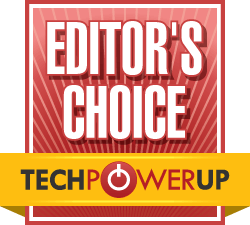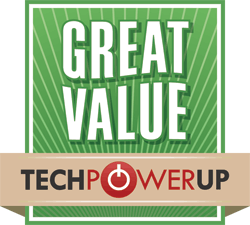 26
26
Crucial BX300 480 GB Review
(26 Comments) »Value and Conclusion
- The Crucial BX300 480 GB SSD is currently available online for $150.
- Outstanding price-per-GB
- Outstanding price/performance
- Uses more durable MLC flash instead of TLC
- Good overall performance
- 7 mm thin—ultrabook compatible
- Acronis TrueImage HD included
- Largest capacity is 480 GB
- Wish it were available as M.2
- No TCG/Opal encryption support
Crucial really surprised us by opting for MLC flash memory at a time where the majority of the market uses TLC chips for their budget-oriented drives. It seems that Samsung's dominance on the SSD market got the company to start some creative thinking. Thanks to the MLC chips and a well-tuned controller, the drive achieves much better performance than its BX200 predecessor, especially when it comes to writes. On the BX200, once the SLC cache was exhausted, performance quickly dropped, sometimes down to mechanical HDD speeds. Not so with the BX300 and its improved SLC cache, which works really well; you'll have a hard time even noticing when it is exhausted.
Overall performance is very good and within a few percent of the fastest SATA drives in our test group. Of course, the M.2 NVMe based drives are much faster in synthetic tests and a bit faster in real-life, but the difference is not that big, especially when you don't copy ISO files all day. Still, it would have been nice of Crucial to offer the BX300 in an M.2 form factor - a growing market where enthusiasts are in dire need of fast and affordable NVMe storage.
What really makes the difference is Crucial's pricing. The tested BX300 480 GB is available for $150, which, while not unheard of, is an extremely good price point for a modern non-TLC drive with good performance. In my opinion, the BX300 is extremely strong competition for Samsung's 850 EVO 512 GB, which currently retails at $150 as well, comes with a warranty that is two years longer, has encryption support, but lacks the MLC chips that make the BX300 excel.


Overall performance is very good and within a few percent of the fastest SATA drives in our test group. Of course, the M.2 NVMe based drives are much faster in synthetic tests and a bit faster in real-life, but the difference is not that big, especially when you don't copy ISO files all day. Still, it would have been nice of Crucial to offer the BX300 in an M.2 form factor - a growing market where enthusiasts are in dire need of fast and affordable NVMe storage.
What really makes the difference is Crucial's pricing. The tested BX300 480 GB is available for $150, which, while not unheard of, is an extremely good price point for a modern non-TLC drive with good performance. In my opinion, the BX300 is extremely strong competition for Samsung's 850 EVO 512 GB, which currently retails at $150 as well, comes with a warranty that is two years longer, has encryption support, but lacks the MLC chips that make the BX300 excel.


Jul 14th, 2025 16:10 CDT
change timezone
Latest GPU Drivers
New Forum Posts
- Share your AIDA 64 cache and memory benchmark here (3099)
- Frametime spikes and stuttering after switching to AMD CPU? (573)
- AAF Optimus Modded Driver For Windows 10 & Windows 11 - Only for Realtek HDAUDIO Chips (578)
- i7 2860QM how to raise power limit? (21)
- AMD 7Ghz? This keeps popping up on my feeds! (6)
- Stupid things one has done with hardware (49)
- No offense, here are some things that bother me about your understanding of fans. (111)
- Choosing the right motherboard (5)
- Best motherboards for XP gaming (151)
- Which CPU to Choose for a 7900 XT? Ryzen 7 7700 or Ryzen 5 9600X? (43)
Popular Reviews
- Lexar NM1090 Pro 4 TB Review
- Our Visit to the Hunter Super Computer
- MSI GeForce RTX 5060 Gaming OC Review
- Fractal Design Epoch RGB TG Review
- NVIDIA GeForce RTX 5050 8 GB Review
- Corsair FRAME 5000D RS Review
- Sapphire Radeon RX 9060 XT Pulse OC 16 GB Review - An Excellent Choice
- Chieftec Iceberg 360 Review
- AMD Ryzen 7 9800X3D Review - The Best Gaming Processor
- Upcoming Hardware Launches 2025 (Updated May 2025)
TPU on YouTube
Controversial News Posts
- Intel's Core Ultra 7 265K and 265KF CPUs Dip Below $250 (288)
- Some Intel Nova Lake CPUs Rumored to Challenge AMD's 3D V-Cache in Desktop Gaming (140)
- AMD Radeon RX 9070 XT Gains 9% Performance at 1440p with Latest Driver, Beats RTX 5070 Ti (131)
- NVIDIA Launches GeForce RTX 5050 for Desktops and Laptops, Starts at $249 (122)
- NVIDIA GeForce RTX 5080 SUPER Could Feature 24 GB Memory, Increased Power Limits (115)
- Microsoft Partners with AMD for Next-gen Xbox Hardware (105)
- Intel "Nova Lake‑S" Series: Seven SKUs, Up to 52 Cores and 150 W TDP (100)
- NVIDIA DLSS Transformer Cuts VRAM Usage by 20% (97)